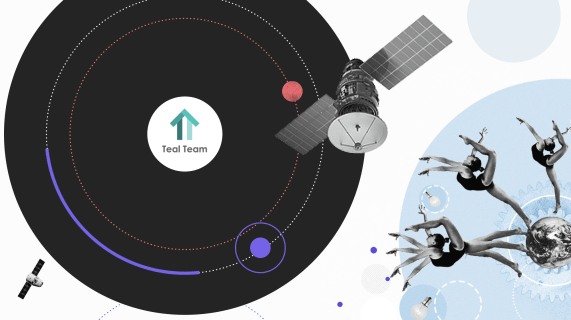From One CEO to Another: My 4 Tips for Choosing a Product Development Company
Bob Dylan’s famous saying, “The times they are a-changin’,” resonates with me now more than ever. In recent years, events like the global pandemic, wars, rising inflation, and the growing role of AI have made it tough for businesses to keep going. The digital world is also affected by these changes, so it’s crucial to put a bigger emphasis on technology-based products and services to keep things efficient. To do more than just get by in this tough market, it’s crucial to work with a reliable partner. In this article, I’ll discuss key factors in selecting a partner, drawing from my 20 years of market experience as the CEO of a product development company.

Table of contents
How to Choose a Product Development Company?
While there are thousands of things to consider when choosing a reliable and efficient product development partner, I will focus only on those fundamental ones. So, for me, here are the most important factors to consider:
- Technical expertise — as your goal is to build a digital product.
- The level of customer experience — because you want to do it as swiftly as possible.
- The processes they use — because building digital products is complicated, and your potential partners need to have a reliable plan for it.
- Experience — because it matters if they built 10 products or 100.
So, let’s take a closer look at these now.
Technology is Still King
This is crucial for obvious reasons: if you want to build digital products that will be significant for your business, you need to work with the best engineers. Knowledge and experience are important, but problem-solving skills and a proactive approach are also essential qualities to look for. How do you check if the company you’re interested in hires the best developers? You can check their LinkedIn profiles, CVs, or simply request a chat with them during a call. One of our partners went through the Career section on our website to see what characteristics we look for in experts, which is quite an interesting approach. If you lack the technical skills to verify someone else’s expertise, ask your potential partner for a referral call with one of their clients.
Is it important how many technologies the company masters? Yes, especially if you want to avoid being limited to one or two technologies that the technological partner is most comfortable with. If possible, look for companies that are technologically agnostic and will focus on finding a solution first, then the suitable technology, not the other way around.
What about the trending Generative AI technology? The reality is, if a development company isn’t interested in incorporating Large Language Models (LLMs) into their products, it suggests they’re not prepared for the upcoming advancements in the field. Generative AI offers a wide range of new tools that can significantly simplify the work of developers and software architects. However, the challenge is that not everyone yet knows how to effectively implement it in their business operations.
How do we ensure that our developers are top-notch experts? We hire engineers who are T-shaped experts in technology and comfortable working on products with a versatile tech stack. During our recruitment process, we look for people who can apply their personal talents to products at various maturity stages and with different business goals. Additionally, during the hiring process, we place special emphasis on software engineers’ soft skills because we want them to communicate easily and have empathy toward our partners’ challenges. And this is a real rarity in the industry.
Customer Approach
If you’re seeking treatment as a partner, choose a company known for its excellence in high-quality customer service. A positive customer experience is shaped by numerous important factors, each reflecting the quality of service. For instance:
- Communication: Is the company punctual, flexible, and willing to adapt its plans to align with yours?
- Standard of Client Care: Does the company serve both large, multinational enterprises and startups equally well?
- Meeting and Role Clarity: Do they provide a clear matrix of meetings and roles, so you know which meetings are essential for your attendance, and which can be managed by the team? Are you informed about whom to approach for technical queries and service-related questions (like payments, contracts, legal support, etc.)?
- Proactivity and Responsiveness: Is the team eager and ready to respond to your inquiries promptly?
As you can see, the topic of service quality is quite broad and can be understood in various ways. To help yourself make a good decision, ask yourself the following questions:
- Do you know whom to contact if you’re dissatisfied with the progress?
- Are you comfortable asking challenging questions?
- How quickly do you receive responses during the initial stages, and what does this suggest about the company’s culture and communication style?
Companies with robust and mature cultures, such as Boldare, often use tools like Service Standards to set clear rules for collaboration. This approach sets boundaries and maintains simple, transparent rules for all involved parties.
Do They Have a Process for That?
Building digital products is incredibly challenging. On one hand, there’s technology and various integrations with third-party tools and services, and on the other, there’s UX and UI design that needs to be aligned with both the business goals and the users’ needs. There are teams responsible for creating the product, alongside the business aspects of the application you want to build. Above all, there’s the budget, which you need to manage tightly to support a positive ROI. How do you ensure all these puzzle pieces fit together?
There’s no simple answer, but I can share the system we use - it’s a combination of Agile and Lean Startup approaches. Both prioritize the value we (and our clients) aim to provide to users, supporting an iterative approach to building software. This means visible progress and working software pieces every week or two, even if they are small. Both Agile and Lean Startup are grounded in the principle of continuous improvement and focus on minimizing broadly defined waste.
In summary, although Agile and Lean Startup represent separate methodologies, they complement each other effectively. Both aim to enhance the product development process through customer-focused, iterative, adaptable, and efficient practices. Many organizations successfully integrate principles from both to optimize their product development cycles and better respond to customer needs.
What should raise a red flag? Be concerned if your potential partner can’t clearly name the framework they use — this might indicate a rigid, waterfall approach. This model is based on the premise that all details must be known at the product’s outset, allowing little to no change during the process. Characterized by a linear, sequential approach with extensive upfront planning, limited flexibility for changes, and a focus on documentation and a defined end product, the Waterfall model stands in contrast to the more flexible, iterative, and adaptive nature of Agile and Lean Startup methodologies.
Grey Hair Indicator
Experience is more than just how old the company is. I understand experience as the fact that someone has already walked your path, dealt with many similar issues, and solved most of them. Experience isn’t always about being the best or being right all the time; it’s about making dozens of mistakes, each with a lesson learned. So, when looking for a company to partner with, don’t just focus on how long they have been in the market. Instead, ask them to describe their most spectacular fuck-up and what they learned from it. That is the real indicator of experience!
On the other hand, it’s essential to recognize that some professionals might place too much emphasis on their own experience and firmly resist other perspectives, even when evidence suggests they might be mistaken. Long-standing experience in the industry does not always equate to always being right. Therefore, an important quality to seek in a partner is their readiness to accept change and question established norms, rather than holding onto obsolete methods or concepts.
Conclusion
Selecting the right product development partner is a decision that requires more than just assessing technical skills. For me, it’s about finding a team that not only has technical expertise and a broad range of technology knowledge but also shows a real commitment to customer partnership and exceptional service.
What I truly value in a partner is their experience, which isn’t just measured in years. It’s about their ability to learn from past challenges and apply those lessons to new projects. That’s why, at Boldare, we embrace failures as tough but invaluable lessons.
When you consider these essential factors, you can find a business partner who’s skilled at navigating the complexities of digital product development and can significantly contribute to your business’s success. Here’s to making the right choice!
Share this article:









